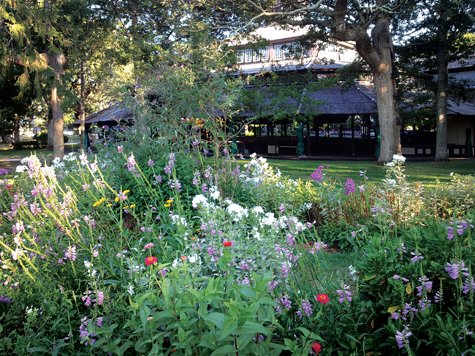GARDENER'S NOTEBOOK

Campground Gardens
By David Kish
Stroll down Circuit Avenue in Oak Bluffs in the summer, and you will find yourself quickly ensconced in the season: crowded sidewalks; slow moving traffic; bustling stores and restaurants. But make a quick right into the Campground, and you are immediately transported to a world of tranquility and history.
I started spending my summers in the Campground as an infant in the late 1960’s, and have spent the majority of summers there ever since. My father was a Methodist minister, and in those days the MVCMA was a Christian retreat where a pastor and his family could vacation and unwind affordably.
Our neighborhood was in one of the outer circles of the Campground, in a neighborhood known as Washington (now Victorian) Park. Much of the activity in the MVCMA tends to be based around the main inner circle, Trinity Park and its nearby neighborhoods, with the Tabernacle, Trinity Church, Cottage Museum and the famous “Pink House” getting much of the attention. The outer circle neighborhoods are the unsung heroes of the Campground, off the beaten track and often overlooked by day trippers and tour groups. This is a garden article and cottage tour of my past and present, seen through the eyes of an enthusiastic child and a appreciative adult. It is a tribute to the outer circle residents, their cottages and their gardens.
The yucca plants that grew in Washington park seemed to be a nuisance to many of us, as children, attempting to play any manner of sport in that tight space. Adults would look on in horror, as we would gleefully bash the yuccas and other plants with a stick or a bat. Now as an adult approaching middle age, I have a great respect and reverence for the yucca, as it has endured and prospered in that same spot for decades.
Across the street my father would sit sentry on our front porch, newspaper in hand, yelling at speeding cars, giving directions to visitors, chatting with neighbors and mostly keeping an eye on mischievous children like myself. It wasn’t until years later that we confessed to such unholy activities like roof jumping with the Harris family, water balloon fights, bible school escapes on our bellies or hellacious bike races with the Matthews down the small streets. Petunias, marigolds and iris plants in the nearby parks were regular targets for our bicycle version of the Indy 500. Despite my slow evolution towards horticultural appreciation, I did have some redemption in those days, as I loved to wander up the street at night and breathe in the incredible fragrances that would abound. Lilac, petunias, honeysuckle, and autumn clematis would intoxicate my senses, and those fragrances were so strong that I am immediately transported back to my youth when I experience them today.
We have had the great fortune of being able to keep the house in the Campground, and having grown up with many of the same families, as neighbors, for more than four decades.
Oddly enough nearly all of my mischievous friends who were fellow plant hooligans have grown up to be avid gardeners and now have children of their own who share this passion, even as their kids are the ones running amuck nowadays. All of us are actively involved in weeding, dead-heading, organic fertilizing, and aiming for that holy grail of the garden: the perfect tomato.
These neighbors are beacons of advice for plant lovers, and there is always a Campground gardener who is willing to offer a division or a cutting or two at the appropriate time of the year. This is a practice that goes back to the Victorian Era, where individuals would give “friendship plants” to neighbors and acquaintances, increasing the presence of the plant within a given area.
Across the street from the park the Scheublins have created a meticulous garden around the once barren land of their cottage, making great use of colorful plants and hearty perennials, and have also experimented with raised beds for vegetables. Every morning Ken Schueblin can be seen fastidiously tending to his cheerful window boxes and hanging planters with great love. He is the current sentry of the park, but it is mainly pesky squirrels and pigeons that seem to be the biggest nuisance these days. “My wife Meta and I are both Leo’s,” he says, “and we are drawn to deep colors and textures, and we feel that the perennials we have chosen compliment the cottage trim and color nicely. We love chatting about gardens and plants with passersby, and we enjoy trading ideas and plants with neighbors”.
On the other side of the park, the Field family have established an immaculate lawn, accented by a hedge of classic blue hydrangea, and a well tended perennial garden, with Shasta daisies, irises, clematis, hostas and liatrus.
Mariko Kawaguchi, author and Lead floral designer at Donaroma’s in Edgartown, has always alluded to the porch being “the smile of the house”, because it is the welcoming place where people congregate and socialize, and this is most certainly the case in the MVCMA. Many Campground residents have made great use of their porches as an extension of their garden, with long blooming annuals in window boxes or hanging baskets accentuating the chimes, flags, signs, furniture and lights. The hanging pots bursting with colorful annuals are a precursor to the Asian lanterns that are hung for the Grand Illumination night at the end of the summer season. This has become one way to beautify these “Wooden tents”.
For many years the beautiful and eclectic gardens in the parks and public spaces of the Campground were designed and maintained by Aloha Long. Now retired, Ms. Long still lives full-time in Cottage City, and maintains a small but gorgeous garden at her home. When she first took over the gardening projects, Aloha was given “free rein to do whatever I wanted,” she says, “as the MVCMA was open to anything and everything at that time”. After planting hydrangeas on the grounds to great acclaim, Aloha then proceeded to tackle the challenge of beautifying some neglected spaces that had great potential, including some of the spaces off the beaten track, and the areas around campground signs. “There used to be just weeds by some of those signs,” she says, “so I planted grass behind them, and then put bright flowers in the front, and everyone loved it so much”. Dahlias continue to be a personal favorite of Aloha, and are the backbone for a late summer garden when many perennials start to wane. Dahlias come in a wide variety of sizes, from the Pom Pom variety that are about the size of a quarter, to the towering “Dinner Plate” dahlias, whose bloom can be as big as a plate, with many sizes and varieties in between.
Just down the street from Aloha, you will find the enchanting abode of Tracey Mace, who maintained and designed Campground gardens for several years as well. A lifelong plant enthusiast, Tracey has created her own Garden Of Eden on the edge of the Campground. It is a magical hideaway with a plethora of floral delights: lambs ear, catalpa trees, Rose of Sharon, China Berry, and Sweet Pea are but a few of the plant treasures to be experienced here. “Many of my plantings are in memory of someone special, or they were gifts from friends and colleagues, or from the many plant places I have worked in over the years”, says Tracey. Beautiful stone walls encircle a charming courtyard in the back of her home, and a claw foot bathtub peeks out from a canopy of vines and shrubs, a unique variation on an outdoor shower. A charming bubbling pond and a vegetable garden add to the feeling of serenity and comfort. “The garden is always evolving and I always look forward to trying new things in it every year”, says Ms. Mace.
In the same neighborhood, Gail Gauthier and Dana Graham are the co-owners of the cottage known as “Piping Plover”, which they bought on Illumination Night five years ago. Ms. Gauthier has been coming to the Campground since she was a teenager, and had an immediate affinity for the house.
For the past several years, the campground gardens have been created and maintained, by Renee Clermont of Second Nature Designs, she continues the practice of creating bright and colorful spaces. “When deciding what look I wanted,” she explains. “I figured, why not match the garden style with the surrounding structures? To me a casual cottage garden was the most obvious approach. The simple layouts are softened by the profusion of plants. However, cottage gardens still need the discipline of repeated color with planting to provide a framework. Using an informal perennial garden as a base, I fill in with annuals, because let’s face it, everyone loves color and lots of it,” she says. Renee’s respect for the surrounding environment and use of saturated color in the public spaces ensure that visitors and residents alike will have many years of garden pleasures in the Campground.
The Grand Illumination is considered by many to be the highlight of the summer season in the Campground. Held every August on a Wednesday evening, it is a colossal festival of lights, with a concert in the Tabernacle and the lighting of beautiful Japanese lanterns among the high points of the occasion. Residents start hanging up the colorful Asian styled lanterns early in the day, with the lanterns often hand made or passed down through the generations. The landscape changes dramatically for this one night, as people light up their gardens and trees, and create magnificent cut flower arrangements for their porches, and the plants and shrubs take on a whole new dimension, one painted by light. Nowadays, LED lights, Christmas lights, solar lights and real candles are used to create an exhilarating luminescent experience. The Tabernacle is filled to capacity with revelers, and thousands more fill up the narrow streets and walkways for the occasion, very different from the more insular Illumination night of yesteryear. Nonetheless, neighbors still saunter over to porches where food and drink may be offered for the occasion, and the culture of porch dwelling takes on added meaning in these moments. In our neighborhood, a block party atmosphere prevails, with music, food and drink, camaraderie, and bright chalk artwork on the pavement all part of the festivities. It is a time for reflection and remembering for many, but also for celebrating, as both the gardens and the Grand Illumination are the cyclical time clocks that there will be blossoms and light again next year, and most importantly, the friendships that continue to bloom as well.
I started spending my summers in the Campground as an infant in the late 1960’s, and have spent the majority of summers there ever since. My father was a Methodist minister, and in those days the MVCMA was a Christian retreat where a pastor and his family could vacation and unwind affordably.
Our neighborhood was in one of the outer circles of the Campground, in a neighborhood known as Washington (now Victorian) Park. Much of the activity in the MVCMA tends to be based around the main inner circle, Trinity Park and its nearby neighborhoods, with the Tabernacle, Trinity Church, Cottage Museum and the famous “Pink House” getting much of the attention. The outer circle neighborhoods are the unsung heroes of the Campground, off the beaten track and often overlooked by day trippers and tour groups. This is a garden article and cottage tour of my past and present, seen through the eyes of an enthusiastic child and a appreciative adult. It is a tribute to the outer circle residents, their cottages and their gardens.
The yucca plants that grew in Washington park seemed to be a nuisance to many of us, as children, attempting to play any manner of sport in that tight space. Adults would look on in horror, as we would gleefully bash the yuccas and other plants with a stick or a bat. Now as an adult approaching middle age, I have a great respect and reverence for the yucca, as it has endured and prospered in that same spot for decades.
Across the street my father would sit sentry on our front porch, newspaper in hand, yelling at speeding cars, giving directions to visitors, chatting with neighbors and mostly keeping an eye on mischievous children like myself. It wasn’t until years later that we confessed to such unholy activities like roof jumping with the Harris family, water balloon fights, bible school escapes on our bellies or hellacious bike races with the Matthews down the small streets. Petunias, marigolds and iris plants in the nearby parks were regular targets for our bicycle version of the Indy 500. Despite my slow evolution towards horticultural appreciation, I did have some redemption in those days, as I loved to wander up the street at night and breathe in the incredible fragrances that would abound. Lilac, petunias, honeysuckle, and autumn clematis would intoxicate my senses, and those fragrances were so strong that I am immediately transported back to my youth when I experience them today.
We have had the great fortune of being able to keep the house in the Campground, and having grown up with many of the same families, as neighbors, for more than four decades.
Oddly enough nearly all of my mischievous friends who were fellow plant hooligans have grown up to be avid gardeners and now have children of their own who share this passion, even as their kids are the ones running amuck nowadays. All of us are actively involved in weeding, dead-heading, organic fertilizing, and aiming for that holy grail of the garden: the perfect tomato.
These neighbors are beacons of advice for plant lovers, and there is always a Campground gardener who is willing to offer a division or a cutting or two at the appropriate time of the year. This is a practice that goes back to the Victorian Era, where individuals would give “friendship plants” to neighbors and acquaintances, increasing the presence of the plant within a given area.
Across the street from the park the Scheublins have created a meticulous garden around the once barren land of their cottage, making great use of colorful plants and hearty perennials, and have also experimented with raised beds for vegetables. Every morning Ken Schueblin can be seen fastidiously tending to his cheerful window boxes and hanging planters with great love. He is the current sentry of the park, but it is mainly pesky squirrels and pigeons that seem to be the biggest nuisance these days. “My wife Meta and I are both Leo’s,” he says, “and we are drawn to deep colors and textures, and we feel that the perennials we have chosen compliment the cottage trim and color nicely. We love chatting about gardens and plants with passersby, and we enjoy trading ideas and plants with neighbors”.
On the other side of the park, the Field family have established an immaculate lawn, accented by a hedge of classic blue hydrangea, and a well tended perennial garden, with Shasta daisies, irises, clematis, hostas and liatrus.
Mariko Kawaguchi, author and Lead floral designer at Donaroma’s in Edgartown, has always alluded to the porch being “the smile of the house”, because it is the welcoming place where people congregate and socialize, and this is most certainly the case in the MVCMA. Many Campground residents have made great use of their porches as an extension of their garden, with long blooming annuals in window boxes or hanging baskets accentuating the chimes, flags, signs, furniture and lights. The hanging pots bursting with colorful annuals are a precursor to the Asian lanterns that are hung for the Grand Illumination night at the end of the summer season. This has become one way to beautify these “Wooden tents”.
For many years the beautiful and eclectic gardens in the parks and public spaces of the Campground were designed and maintained by Aloha Long. Now retired, Ms. Long still lives full-time in Cottage City, and maintains a small but gorgeous garden at her home. When she first took over the gardening projects, Aloha was given “free rein to do whatever I wanted,” she says, “as the MVCMA was open to anything and everything at that time”. After planting hydrangeas on the grounds to great acclaim, Aloha then proceeded to tackle the challenge of beautifying some neglected spaces that had great potential, including some of the spaces off the beaten track, and the areas around campground signs. “There used to be just weeds by some of those signs,” she says, “so I planted grass behind them, and then put bright flowers in the front, and everyone loved it so much”. Dahlias continue to be a personal favorite of Aloha, and are the backbone for a late summer garden when many perennials start to wane. Dahlias come in a wide variety of sizes, from the Pom Pom variety that are about the size of a quarter, to the towering “Dinner Plate” dahlias, whose bloom can be as big as a plate, with many sizes and varieties in between.
Just down the street from Aloha, you will find the enchanting abode of Tracey Mace, who maintained and designed Campground gardens for several years as well. A lifelong plant enthusiast, Tracey has created her own Garden Of Eden on the edge of the Campground. It is a magical hideaway with a plethora of floral delights: lambs ear, catalpa trees, Rose of Sharon, China Berry, and Sweet Pea are but a few of the plant treasures to be experienced here. “Many of my plantings are in memory of someone special, or they were gifts from friends and colleagues, or from the many plant places I have worked in over the years”, says Tracey. Beautiful stone walls encircle a charming courtyard in the back of her home, and a claw foot bathtub peeks out from a canopy of vines and shrubs, a unique variation on an outdoor shower. A charming bubbling pond and a vegetable garden add to the feeling of serenity and comfort. “The garden is always evolving and I always look forward to trying new things in it every year”, says Ms. Mace.
In the same neighborhood, Gail Gauthier and Dana Graham are the co-owners of the cottage known as “Piping Plover”, which they bought on Illumination Night five years ago. Ms. Gauthier has been coming to the Campground since she was a teenager, and had an immediate affinity for the house.
For the past several years, the campground gardens have been created and maintained, by Renee Clermont of Second Nature Designs, she continues the practice of creating bright and colorful spaces. “When deciding what look I wanted,” she explains. “I figured, why not match the garden style with the surrounding structures? To me a casual cottage garden was the most obvious approach. The simple layouts are softened by the profusion of plants. However, cottage gardens still need the discipline of repeated color with planting to provide a framework. Using an informal perennial garden as a base, I fill in with annuals, because let’s face it, everyone loves color and lots of it,” she says. Renee’s respect for the surrounding environment and use of saturated color in the public spaces ensure that visitors and residents alike will have many years of garden pleasures in the Campground.
The Grand Illumination is considered by many to be the highlight of the summer season in the Campground. Held every August on a Wednesday evening, it is a colossal festival of lights, with a concert in the Tabernacle and the lighting of beautiful Japanese lanterns among the high points of the occasion. Residents start hanging up the colorful Asian styled lanterns early in the day, with the lanterns often hand made or passed down through the generations. The landscape changes dramatically for this one night, as people light up their gardens and trees, and create magnificent cut flower arrangements for their porches, and the plants and shrubs take on a whole new dimension, one painted by light. Nowadays, LED lights, Christmas lights, solar lights and real candles are used to create an exhilarating luminescent experience. The Tabernacle is filled to capacity with revelers, and thousands more fill up the narrow streets and walkways for the occasion, very different from the more insular Illumination night of yesteryear. Nonetheless, neighbors still saunter over to porches where food and drink may be offered for the occasion, and the culture of porch dwelling takes on added meaning in these moments. In our neighborhood, a block party atmosphere prevails, with music, food and drink, camaraderie, and bright chalk artwork on the pavement all part of the festivities. It is a time for reflection and remembering for many, but also for celebrating, as both the gardens and the Grand Illumination are the cyclical time clocks that there will be blossoms and light again next year, and most importantly, the friendships that continue to bloom as well.









